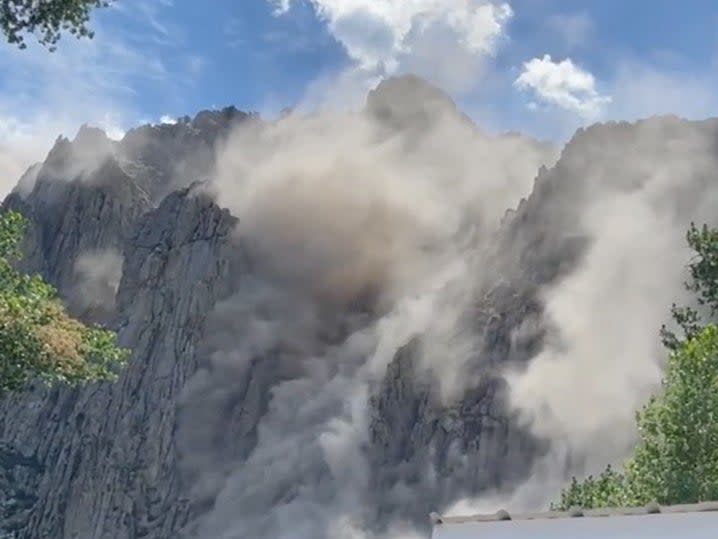Videos show boulders sliding towards highway as earthquake shakes California-Nevada border

Videos show boulders raining towards highways along the California-Nevada border as an earthquake with a preliminary magnitude of 6.0 shook the Sierra county area.
People reported feeling the rattling hundreds of miles away, according to the US Geological Survey. No serious damage or injuries have been reported so far.
The earthquake hit the area around 3.49pm local time on Thursday, about 250 miles east of San Francisco and south of Lake Tahoe in northern California.
The epicentre was four miles outside the town of Walker, where around 900 people live, the Associated Press reported.
Dozens of aftershocks followed the earthquake with at least six of them registering a magnitude of 4.0 or more, the US Geological Survey reported.
“The ground was shaking pretty bad, and then everything started falling,” Carolina Estrada, manager at the Walker Coffee Company, told the AP. Bottles of syrup broke, dishes fell to the floor and the shop’s roof partially caved in.
Ms Estrada said the shaking lasted 30 seconds or more. “We ran out of the building,” she said. As the shaking continued, “boulders the size of cars” fell onto a nearby highway, she added.
Boulders everywhere after earthquake on i395 #earthquake #california #roadtrip pic.twitter.com/Bdw4he17ni
— Brett Durrant (@brettdurrant) July 9, 2021
The California Highway Patrol said cars were struck by the boulders, but no one was injured. The rockslides resulted in the closure of about 40 miles of the interstate at one point, authorities said.
Reno mayor Hillary Schieve told the Reno Gazette-Journal that City Hall was evacuated. “It shook pretty good,” the mayor said.
Earthquake hit us on I395 near Coleville, CA! Boulders all over the road! #earthquake #California #roadtrip @ABC pic.twitter.com/ZoTxLnC6r8
— Brett Durrant (@brettdurrant) July 9, 2021
With a depth of 6 miles, residents around Lake Tahoe and all the way to Fresno, California felt the earthquake. It was also felt in Las Vegas, Nevada.
The epicentre was close to the Antelope Valley fault, which experienced the largest earthquake since 1994, when a quake with a magnitude of 6.1 was recorded.
Video I obtained of boulders coming down in Coleville near the epicenter. Complete coverage on @nbcbayarea right now pic.twitter.com/mIzDbj0G35
— Eric Rich (@ScoopRich) July 9, 2021
Seismologist Lucy Jones tweeted that it was “a classic normal faulting earthquake for eastern California,” adding that aftershocks were common in the region.
“People in the area should expect aftershocks for days following an earthquake of this size,” Jason Ballman at the Southern California Earthquake Centre said.
Damage or injury reports might not come in for days, Mr Ballman said, as the quake was felt in many remote areas.
Research geophysicist Sarah Minson at the US Geological Survey’s Earthquake Science Centre told the San Francisco Chronicle that the Sierra Nevada is an active earthquake zone but that the quakes usually “fly under the radar” as the area is sparsely populated. She added that the area is “quite seismically active”.
Dr Minson said: “There is no particular reason to think one big earthquake is related to any other big earthquake.”
Earthquakes of this magnitude are rare and usually don’t occur one after the other, she added. But she said that double quakes can happen, such as in July 2019 when two quakes hit southeast California less than two days apart.
The first one registered a magnitude of 6.4 and the second registered as a 7.1 only 34 hours later. But Dr Minson said scientists don’t have clear evidence that they were related.
USGS geologist Austin Elliott told the AP that earthquakes are common along this fault, citing a magnitude 5.8 earthquake shaking the town of Lone Pine in the Eastern Sierra last month, which sent boulders falling down Mt Whitney.
Read More
How likely is ‘the Big One’ earthquake to hit west coast after recent LA tremors?
Watch US Navy trial causing earthquake after blasting 18 tonnes of explosives in Atlantic

